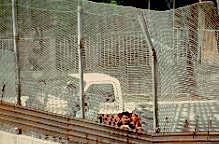Texts and Contexts: How many sides does a border have?

Texts and Contexts: How many sides does a border have? |
|
 |
This is a collection of questions, links, and readings around the idea of "borders." As discussed in "Chapter One: Approaching Borders," a border is defined as "any place where differences come together," and where those differences matter. The sites below are links to Web resources exploring some of the possible meanings for borders: geographical, ethnic, intercultural, and political. |
Questions & Activities
|
|
|
| On the Web: | In Border Texts: | |
| The
Problem of Identity in a Changing Culture: Essay dealing with identity
in a changing culture along the Rio Grande from the Borders Frontera web
site.
Who Lives on the Border? This page looks at individuals who live on the Border, it is also provided by the Borders Frontera web site. Human Rights Have No Borders: An Amnesty Organization refugee report which gives different essays concerning various refugees and international cooperation. One People: A web site for One People Magazine, which strives to become united with the world. They have a collection of 45-50 interviews with those individuals who are vehemently against racism and inequality. Other Anti-racism Sites - This web site is a jumping off point to find other sites that are against racism. Virtual Geography Department: A web page for the virtual geography home page at University of Texas. Internet Users are able to take vitrual field trips to different countries from this page. |
These Web sites, and others
like them are designed to connect especially with "Chapter One: Approaching
Borders."
You might also consider these sites in connection with some of the stories dealing with biculturalism and binationalism, such as Cofer's "Silent Dancing," or Cruz's "Home is where the music is," or Mukherjee's "Two Ways of Belonging in America." Or, you might consider these sites in light of the writings on the US Southwest "borderlands," such as Anzaldua's "The New Mestiza," or Gomez-Pena' "The Tortilla Curtain." The concept of borders and their character as cultural constructions can be seen in other stories, such as Blaise's "The Border as Fiction," and Thomas King's "Borders." Many of these sites also connect with the theme of geography and the cultural meaning of geographic representation, such as in the "Third World Atlas" selection or Anderson's essay about nations as "Imagined Communities." Many of the sites here are about international
themes, and in particular, organizations using the Web's global capabilities
to bridge across national boundaries. In this way, these sites raise many
questions and problems relating to globalization and post-nationalism,
as do many of the essays in Chapter Seven: The World's New Borders.
|
|